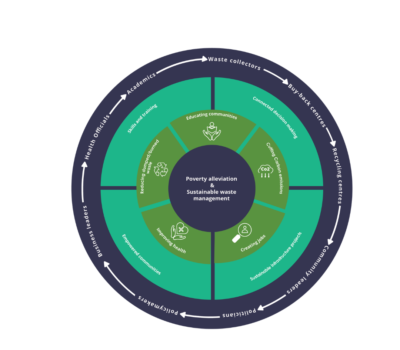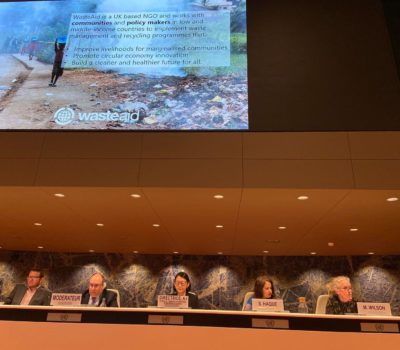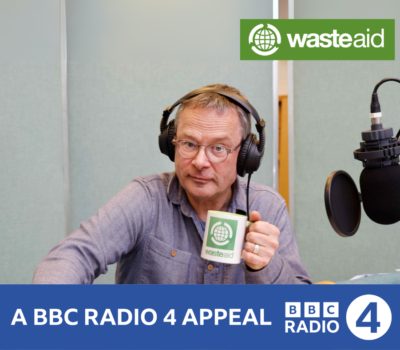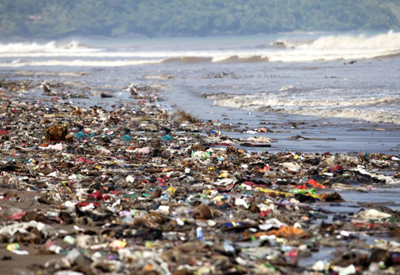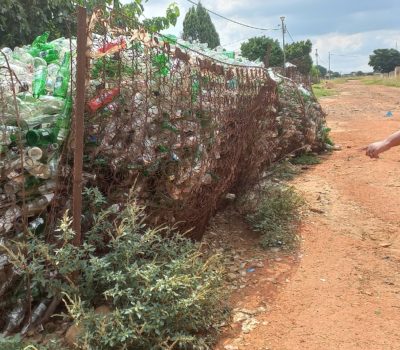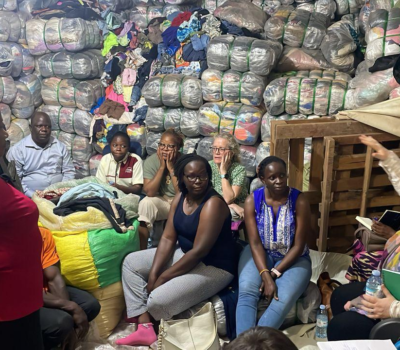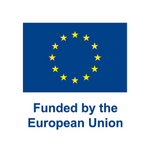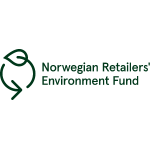Better waste and resource management can contribute significantly to climate mitigation
Thought Pieces
Author: Guest Author
Published: 27 June 2022
Article contributed by David C Wilson, Visiting Professor in Waste and Resource Management at Imperial College London and Patron of WasteAid.
I want to talk about how much the waste and resources sector can contribute to mitigating global heating; and to make the case for prioritising actions at COP26 and beyond to improve waste and resource management and move towards the circular economy.
Waste and resource management and climate change
Municipal solid waste management is an essential utility service, but is not often recognised as such; in the Global North we take our clean cities for granted, unless there is a disruption to the regular waste (garbage) collection service. However, for at least a third of the World’s population, there is no waste collection service[i] and people need to self-manage their own solid waste; by open burning, ‘wild’ dumping on land or into water, or at a communal dumpsite. Even when waste is collected, it often goes to an uncontrolled municipal dumpsite, which may be continuously on fire.
In the Global North, universal collection dates to the 19th Century, and upgrading standards for land disposal and incineration dates to the 1970s. Much progress has been made since in diverting waste from landfill, increasing recycling rates and preventing waste. End-of-pipe ‘waste management’ has become more integrated ‘waste and resource management’, with the aspiration of a truly circular economy[ii].
Waste and resource management can contribute to combatting climate change in at least four ways. It is (1) an important source of methane through the decomposition of organic materials in uncontrolled or controlled landfill sites; and (2) of black carbon from open burning of waste. Both methane and black carbon are among so called short-lived climate forcers (SLCFs), which have much greater global heating potentials than carbon dioxide, and decay more quickly in the atmosphere, which means that reductions in emissions will have a greater short-term impact on climate mitigation than comparable reductions in carbon dioxide. But moving from end-of-pipe waste management towards resource management and the circular economy also has carbon benefits by enabling savings in other economic sectors, through (3) recycling and recovery and (4) waste prevention.
Perception versus reality
The waste sector is often perceived in the climate community as having only a small (albeit important) contribution to make. This arises from the accounting conventions used to avoid any possibility of double counting; IPCC use a 2-D matrix with sectors of the economy on one axis and individual countries on the other. ‘Waste management’ is defined as one of the 10 or so sectors; IPCC’s 5th Assessment Report (AR5)[iii] attributed 3-5% of global greenhouse gas (GHG) emissions (carbon dioxide equivalent – CO₂eq) to the waste sector in 2010.
More than 90% of this contribution came from methane, which is just one of the four contributions enumerated above. But even there, the estimate is low. In the Global North, actions to collect and control methane emissions from landfill date back to the 1970s, well before the 1990 baseline date used for carbon accounting. Taking figures for the UK as an example, the waste sector accounted for 90 million tonnes (Mt) CO₂eq in 1990, out of the UK total of 890Mt; which had reduced by 2010 to 41 Mt out of a total of 690 Mt; and by 2018 to 33 Mt out of a total of 530 Mt[iv]. So by 2010, the waste sector’s emissions had been reduced by 55% from their 1990 baseline; the sector’s contribution to the total UK emissions had declined from 10% to 6%; and the sector had provided around 25% of the UK’s total emissions cuts over 20 years.
Methane gas collection at the former Payatas controlled landfill in Quezon City. Photo: Solid Waste Association of the Philippines
These impressive levels of carbon mitigation between 1990 – 2010 were achieved both by further methane control and by diverting wastes from landfill, through recycling dry materials, diverting organics to anaerobic digestion and composting, and reducing food waste at source (e.g. through WRAP’s Love Food Hate Waste campaign[v]). But the carbon benefits of recycling and waste prevention go way beyond reducing direct methane emissions from the waste sector. Again using the UK as an example, a recent industry report suggests that sorting and recycling alone helped avoid 45 MtCO₂eq emissions in 2018[vi]; while a WRAP report shows that food waste accounts for 36 Mt[vii]. So, both the avoided emissions across the economy of producing virgin materials displaced by recycling (contribution (3) above), and the carbon cost of producing food that we throw away (just one part of contribution (4)), each exceed the 33 MT total emissions in 2018 from the end-of-pipe waste sector.
Focusing on low- and middle-income countries (LMICs)
Turning attention now to the Global South, a major priority to protect public health is to bring wastes under control, by increasing the proportion of municipal solid waste collected to 95+% and by phasing out uncontrolled disposal and open burning (SDG indicator 11.6.1[viii]). Both local and global environmental benefits are huge – one estimate is that the mass of plastics reaching the oceans each year could be cut at least in half[ix]. The global climate benefits are also large, although reported GHG emissions could potentially increase in the short term. One reason is that waste data are traditionally poor; as management improves, so will measurement, thus increasing the reported figures. A second is that, as wastes are brought under control, the potential for methane emissions from anaerobic decomposition in landfill will increase. One result is that in many low- and middle-income countries (LMICs), the narrow waste sector could easily exceed the 1990 UK contribution of 10% to total emissions. Another is that, as waste generation rates per capita continue to increase in LMICs and stabilise or decline in high-income countries[x], the IPCC’s measured global contribution from the waste sector would increase over time if mitigation actions were not taken.

All of this neglects contribution (2) above, that of black carbon emissions from the open burning of waste. A lack of data kept this out of any quantitative assessment by the IPCC up to AR5 in 2013. Research since then by Natalia Reyna, my student at Imperial College London, estimated that black carbon emissions from open burning of waste could contribute between 2-10% of global CO₂eq emissions[xi]. The recent IPCC AR6[xii] does at least now include this as a source, although its estimate of 9% of black carbon emissions due to open burning of waste falls below the 10% threshold above which waste management would have made it into the high-level reports as a significant source. Nonetheless, addressing the scandal of one third of the world’s population without access to basic solid waste services, by extending waste collection and controlled recovery and disposal to all (achieving 95+% on SDG indicator 11.6.1), would effectively eliminate open burning, and provide a substantial short-term ‘win’ in terms of climate mitigation. That is a low hanging fruit which must be harvested.
Waste and resource management as a priority for climate mitigation
When I started working as an international waste management consultant in the 1970s, the sector had indeed the narrow, end-of-pipe focus implied by the necessary accounting conventions adopted by the IPCC. Over the last 25 years, the sector has worked hard to move, first to a broader focus on waste and resource management, and now towards the aspiration of a truly circular economy. As a member and Past President of the UK professional body, CIWM, I am no longer a Chartered Waste Manager but rather a Chartered Resource and Waste Manager; our new purpose is ‘to move the world beyond waste’[xiii]. But the perception in the climate community, and among policy and decision makers, is still based on the official IPCC numbers, which show that the narrow end-of-pipe waste sector was a relatively small contributor to global GHG emissions in 2010, and thus not a priority for investment when it comes to mitigation.
My key message is that this perception is wrong. We need to find ways to convey the bigger picture – that the emissions from the waste and resource management sector itself are far outweighed by its potential for enabling much larger savings across multiple other sectors of the economy, BOTH from recycling & recovery of wastes, and from waste prevention.
How big could that contribution be? Given the notoriously poor data on waste and resource management, the best we can do is rough estimates[xiv]. Conservative estimates for each of the three contributing segments: direct emissions from waste management, focused mainly on methane from land disposal and black carbon from open burning; indirect savings in other sectors from recycling and recovery; and indirect savings from waste prevention; would give a range for each of 5-10% or more.
Adding the three segments together adds further to the uncertainty; but whether that figure is 15%, 20% or even higher is frankly immaterial – the point is that we have high confidence that the overall contribution is large, and needs to be recognised, and integrated into the Nationally Determined Contributions (NDCs), if we are to have a chance of limiting global heating to 1.5°C or 2.0°C.
In summary, we need to put better waste and resource management firmly on the agenda at COP26 and beyond.
About the author
David Wilson has been an international waste and resource management consultant for more than 40 years, and a Visiting Professor at Imperial College London for the last 20. He has been lead author for seminal publications including UN Habitat’s Solid Waste Management in the World’s Cities (2009) and UNEP & ISWA’s Global Waste Management Outlook (2015). He was the 2017-18 President of CIWM, the UK professional body for resources and waste, and is a Patron of WasteAid.
References
[i] UNEP and ISWA, 2015. Global Waste Management Outlook. Eds: D. C. Wilson & A. Carpintero-Rogero. https://www.unenvironment.org/resources/report/global-waste-management-outlook
[ii] Andrew Whiteman, Mike Webster and David C Wilson, 2021. The nine development bands – A conceptual framework and global theory for waste and development. Waste Management & Research, 39(10), 1218-1236. Open access: https://doi.org/10.1177%2F0734242X211035926
[iii] IPCC, 2013. 5th Assessment Report (AR5). https://www.ipcc.ch/assessment-report/ar5/
[iv] The Committee on Climate Change, 2020. The Sixth Carbon Budget. Waste. https://www.theccc.org.uk/wp-content/uploads/2020/12/Sector-summary-Waste.pdf
[v] WRAP. Love Food Hate Waste. https://www.lovefoodhatewaste.com/
[vi] ESA, 2021. A net-zero greenhouse gas emissions strategy for the UK recycling and waste sector. https://www.esauk.org/download_file/view/1160/194
[vii] WRAP, 2021. UK food systems GHG emissions. https://wrap.org.uk/resources/report/uk-food-system-ghg-emissions
[viii] UN-Habitat, 2021. Waste Wise Cities Tool: Step-by-Step Guide to Assess a City’s MSWM Performance through SDG indicator 11.6.1 Monitoring. Prepared by UN Habitat, Wasteaware, EAWAG and University of Leeds. https://unhabitat.org/wwc-tool
[ix] CIWM and WasteAid, 2018. From the Land to the Sea – How better solid waste management can improve the lives of the world’s poorest and halve the quantity of plastic entering the oceans. https://wasteaid.org/wp-content/uploads/2018/04/From-the-Land-to-the-Sea.pdf
[x] Silpa Kaza, Siddarth Shrikanth, and Sarur Chaudhary, 2021. More growth, less waste. World Bank Urban Development Series. https://www.worldbank.org/en/topic/urbandevelopment/publication/more-growth-less-garbage
[xi] Natalia Reyna-Bensusan, David C.Wilson, Pamela M. Davy, Gary W.Fuller, Geoff D.Fowler and Stephen R. Smith, 2019. Experimental measurements of black carbon emission factors to estimate the global impact of uncontrolled burning of waste, 2019. Atmospheric Environment, 213, 629-639.
[xii] IPCC, 2021. 6th Assessment report (AR6). https://www.ipcc.ch/assessment-report/ar6/
[xiii] CIWM, 2021. Leading the Way to a World Beyond Waste. Our Strategy 2022-2027. https://www.ciwm.co.uk/ciwm/ciwm-strategy.aspx
[xiv] Wilson, D. C., Reyna-Bensusan, N. & Pfaff-Simoneit, W., 2015. Topic Sheet 1: Waste and Climate. In: UNEP & ISWA, Global Waste Management Outlook, op. cit., pp. 12-15.



